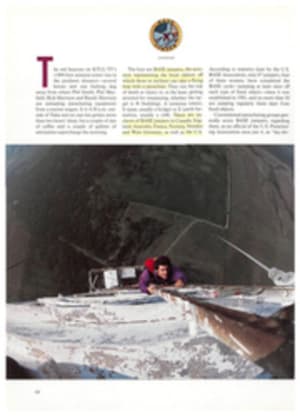
WARY AT FIRST, AN AUDUBON CAMPER LEARNS TO LIKE LIFE ON THE WILD SIDE
...I sit here growing old by inches
Watching the clock instead of the finches
But sometimes I visualize in my gin
The Audubon I audubin
—Ogden Nash
Two summers ago, when I told friends of my desire to attend the Audubon Ecology Workshop in Greenwich, Conn., responses ranged from the incredulous ("Camp? At your age?") to the sarcastic ("Don't forget to sew name tags into your clothes") to the horrified ("Does this mean that you're going to go bird watching?").
I saw no cause for the hoopla. First, the camp was for adults, so my age was irrelevant. Second, my name tags are already sewn into my clothes. Finally, I had no interest in bird watching. Birders, as every city slicker knows, are a breed apart, a strange species with binoculars for eyes. No, my reason for going to camp was simply to get away from a week's worth of summer in New York City and enjoy nature. I had read about the four camps that the Audubon Society runs, and while the sites in Wyoming and Wisconsin sounded great, they were too far away. Maine's sessions lasted two weeks and I wanted to stay only one—which left Greenwich, only 40 minutes from home. It was just as well—Greenwich was the only camp offering introductory sessions, and I could barely tell the difference between a water bug and a ladybug. Not only would I delight in "the tranquility of silent woodlands opening into rolling meadows, the discovery of crayfish in a meandering stream, the surprise of a pileated woodpecker drumming in a tree overhead," but I would also learn about the impact humans have on our environment. Of all the camps, the one in Greenwich had the most modern facilities—a library, two-to-a-room lodging with bath—and cost a reasonable $375 for the week, meals included. I signed up for the very first session of the season.
Several months later, I found myself a member of a group of 23 campers. Included were Randi, a school psychologist from Ohio; Norm, a New York City attorney; Kathleen, a marketing representative from just outside Chicago; and Connie, a storyteller from Pennsylvania. The grandmother-granddaughter combo of Louise (retired farmer) and Deena (a graduate student) had journeyed the farthest, from Milford, Iowa and Omaha, respectively. All told, we ranged in age from about 18 to 75, with two married couples and six students in our ranks.
The Greenwich camp nestles amid 485 acres of land that originally belonged to the Siwanoy Indians. The Audubon Society acquired more than half of its present Greenwich holdings in 1942 and three years later added the 135 acres that make up Fairchild Garden, a wildflower preserve. Today, Audubon's Connecticut sanctuary is home to more than 800 species of plants, 35 species of mammals and 150 species of birds.
On our first full day, we were divided into four groups, and almost immediately we got down to the business of learning about nature. First, from a trail near Mead Lake, we watched a giant turtle, perhaps 60 years old, hastily glide into the water. We were still marveling at its size and agility when our group leader, Ted, shushed us. "Something's nearby," I thought excitedly. "Maybe a deer or a bear or...." I imagined the tales I'd tell back home and listened intently. Birds sang, water lapped against the lake's shore and leaves rustled overhead. Ted approached his target, pointed into a thicket of trees, then cupped his hands around his mouth.
"Twit, twit, sweet, sweet, chew, chew," he called. Presently, a bird responded. That, he explained, was a waterthrush. I thought he must be crazy. While a very real mosquito explored my ear, this guy was calmly conversing with an invisible bird. Ted looked through his binoculars, spotted the thrush and directed the group's gaze toward it. A lousy waterthrush. I was far more interested in finding the turtle again; at least the turtle sparked a poignant childhood memory—the time my brother, Neal, and I accidentally discovered that turtles and scalding water don't mix. The thrush, on the other hand, meant nothing to me.
Ted started talking about the bird: We would always recognize this brown thrush because it frequented thickets near the water and it bopped as it walked along the lower branches of trees. Bopped? "Yes," said Ted. "As if it had a built-in Walkman." Well, any bird that bopped was worth seeing and I had to admit that any bird with a built-in Walkman was my kind of bird. I peered in the general direction of the thrush, but without binoculars I could see only a wall of green and brown.
Midway into the week, we arose early for an excursion to Fairchild Garden. By that time, I had discovered there was an enticing quality about the outdoors—something that made me want to breathe as much fresh air and observe as much natural beauty as I could. And that beauty, surprisingly enough, included birds. Quietly, I cast my big-city cynicism aside, borrowed a pair of binoculars, and turned my sights to the sky.
It was a slow morning, however, and our small group spotted only a red-eyed vireo here, a robin there. Eventually, we wound up at Turtle Pond in hopes of some better sightings, and we weren't disappointed. Almost immediately we saw a bird with a brown back and white breast in full display on a limb hanging over the middle of the pond. Courtney, a summer intern, was beside himself. "This may be the find of the week," he exclaimed, and told us to note the bird's black bill and the red circle around its eyes. It was a black-billed cuckoo, only the second that Courtney had seen. Normally this cuckoo is secretive, with a penchant for hiding in bushes and trees at the first hint of humans. Yet there it perched, proudly, for all to see. After we had gazed our fill, it lifted off and flew away.
Later that afternoon, my roommate, Susan, and I walked over to the bird blinds near a lake on the Audubon property. The blinds look something like wooden houses on stilts and have rectangular windows from which the lake and a small island in the middle of it are visible. Through those windows we entered a world of ducks, muskrats and birds of myriad colors, sizes and shapes. Birds flitted from branch to branch, soared over trees, cruised close to the water's edge, sang. For more than an hour we sat, elbows propped upon a wooden ledge, and enjoyed the show. Most of the time we didn't know what types of birds we were seeing, so whenever we did get one right (verified in Susan's field guide) it was cause for celebration. At one point, recalling a distress call that Ted sometimes made, I ventured a feeble "Swisst, swisst, swisst." Susan joined in with a call of her own, and before long we were laughing hard. So this was what a few days at an Audubon camp could do to you.
There was more to the camp than just birds, though. Through lectures, we also learned a little about geology, astronomy, meteorology and biology. We discovered that all bugs are insects but not all insects are bugs, and that deer have no upper front teeth. We made friends with a blue bird named Dr. Jay, Chuckie the woodchuck and two young raccoons named Snort and Grunt. We also watched white-tailed deer, their tails straight as soldiers, flee into the forest sanctuary. With Ted's help, we were even able to spot a spider's web in the dark.
But for me, the birds were the highlight. Toward the end of the week, I bought my own field guide, and early in the morning I would go to a bench near Indian Pond. There, with my guide in one hand, Thoreau's Walden in the other and my binoculars around my neck, I would contemplate the world and how little I knew of it. Perhaps thousands of life forms were within 100 feet of me, yet I could see and identify only a few.
Dusk was approaching; I would be leaving for New York City the next day. I thought of some of the birds we'd seen at camp—the kingbird and the male yellow warbler, the swans and the barn swallow, the American egrets on Long Island Sound, the black-billed cuckoo and the cardinals—and I was filled with a sense of futility. The workshop had been fun, it had been a learning experience, but now, however, it was over, and everything I had learned would be forgotten all too quickly. Although Phil, the camp's director, said that many people went bird watching in Central Park, I knew I would never join them—partly because there were so many other day-to-day distractions to contend with, but mostly because nature and New York City seemed, to me, pretty incompatible.
So I went back home and resumed the routine of my life. A few weeks later I was sitting on the steps of the New York Public Library on Fifth Avenue, when a small brown bird landed nearby. It looked a lot like a mockingbird. "Can't be," I said to myself. "Mockingbirds are grayer and have a white breast." Even if I didn't know what type of bird it was, at least I knew one type it wasn't. I hadn't forgotten it all. My thoughts returned to camp and something Connie had said about a woman she knew who went birding in Switzerland every year. Before camp, Connie could never understand the woman's compulsion, but now it was beginning to make sense. "When you see a bird and identify it, suddenly you feel as though you belong," she said. "You're part of the outdoors."
For a brief moment, even without identifying the bird, I felt I was again part of the outdoors. It was as if nature had come to Fifth Avenue—cars, concrete, congestion and all. For a city slicker, it was a really nice feeling.
TWO ILLUSTRATIONS
LAURA CORNELL

